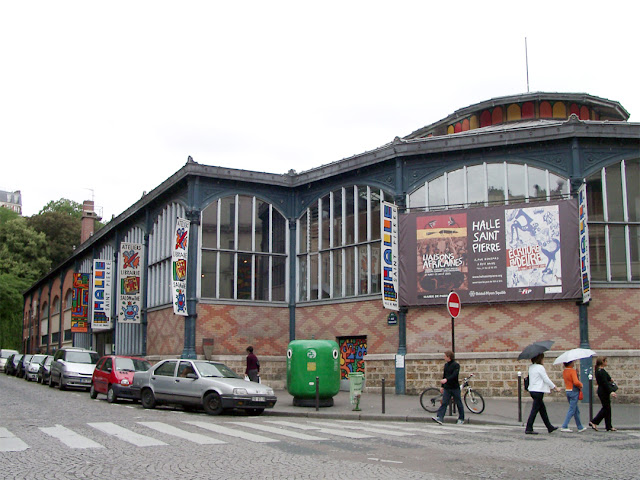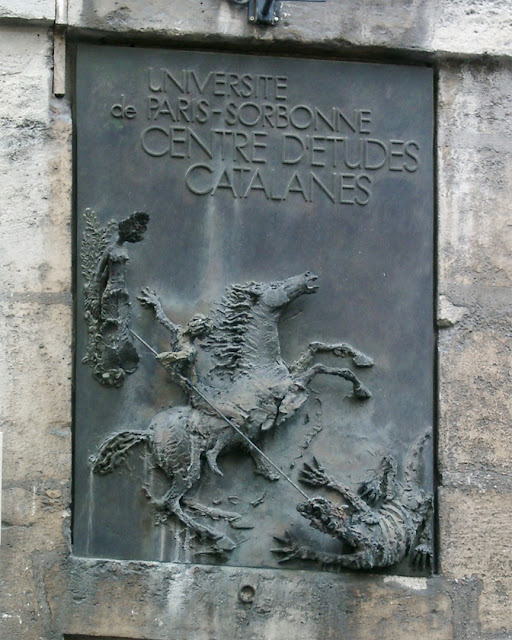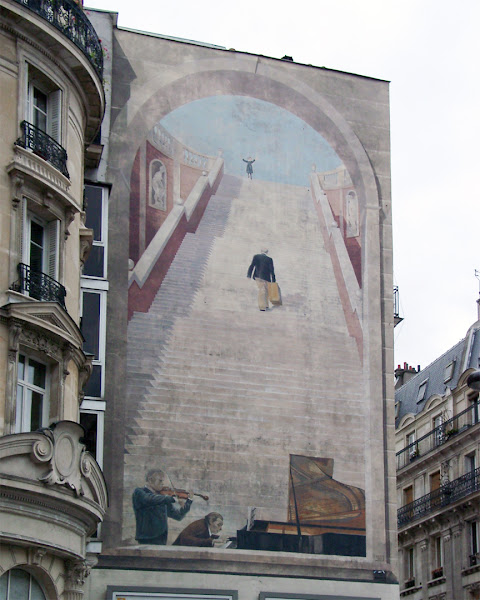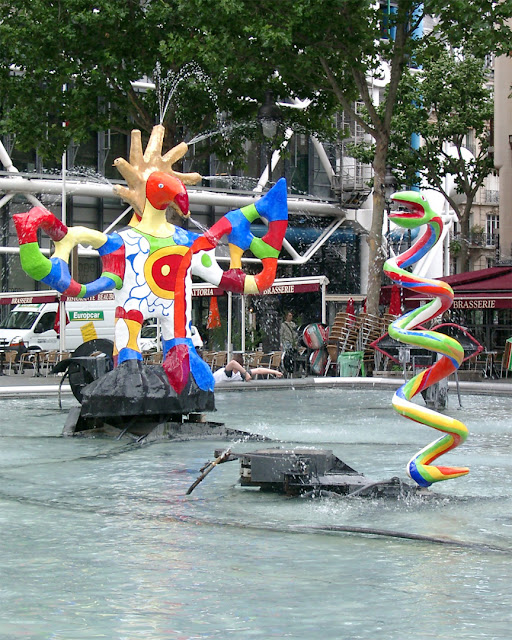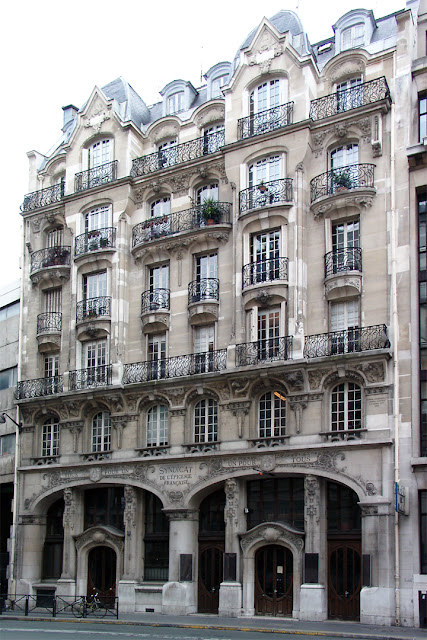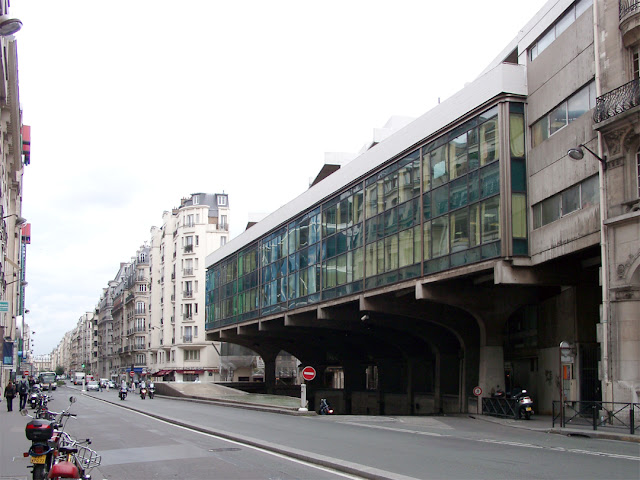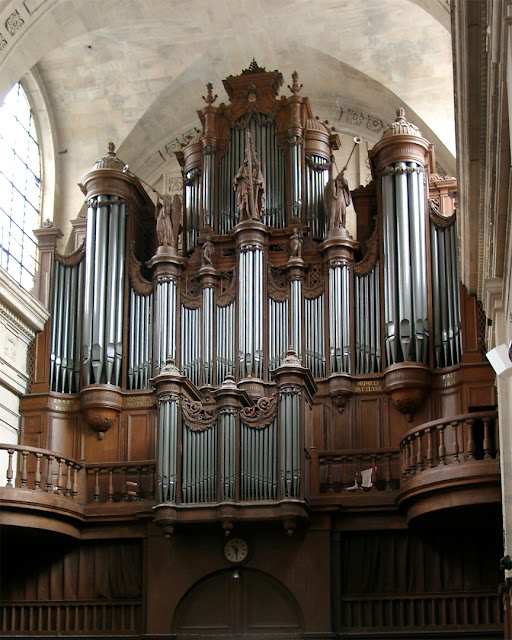Saturday, December 31, 2005
Friday, December 30, 2005
Rue Foyatier
Flights of stairs
Rue Foyatier
Quartier de Clignancourt, 18th arrondissement
Paris, July 2005
“The Rue Foyatier is a street on the Montmartre butte (outlier), in the 18th arrondissement of Paris. Opened in 1867, it was given its current name in 1875, after the sculptor Denis Foyatier (1793–1863). One of the most famous streets in Paris, it consists of flights of stairs giving access to the top of the hill, the Sacré-Cœur Basilica, and the other attractions of the upper-Montmartre neighborhood. The Montmartre funicular runs alongside it.” (Rue Foyatier, Wikipedia)
Thursday, December 29, 2005
Théâtre de l'Atelier
Théâtre de l'Atelier
Place Charles-Dullin
Quartier de Clignancourt, 18th arrondissement
Paris, July 2005
“The theatre opened on 23 November 1822 under the name Théâtre Montmartre It was one of the first built by Pierre-Jacques Seveste, who held the licence to operate theatres outside the town limits of Paris, and who also built the Théâtre Montparnasse, the Théâtre des Batignolles and the Théâtre de Belleville. Peter Cicéri and Évariste Fragonard did the decoration. On the death of their parents, brothers Jules Seveste and Edmond Seveste inherited the licence to operate the theatre. From 1914 to 1922, the building comprised a cinema of 600 seats, operated under the name ‘Montmartre.’ In 1922, it returned to its original purpose, and its director and actor Charles Dullin renamed it the Théâtre de l'Atelier. André Barsacq succeeded Dullin, and led the theatre from 1940 to 1973. He produced the works of Jean Anouilh, Marcel Ayme, Françoise Sagan, René de Obaldia, and Friedrich Dürrenmatt—among others. From 1973 until December 1998, Pierre Franck took over, along with his wife Danielle Frank.[citation needed] He continued his work as director and maintained high standards in the choice of repertoire with works by Pirandello, Ionesco, Beckett, Thomas Bernhard, Strindberg—and with actors such as Michel Bouquet and Laurent Terzieff. Laura Pels assumed the leadership in January 1999. The current capacity is 563 seats. The theatre was classified a historical monument on 22 March 1965.” (Théâtre de l'Atelier, Wikipedia)
Wednesday, December 28, 2005
Élysée Montmartre
Élysée Montmartre
Boulevard Rochechouart
Quartier de Clignancourt, 18th arrondissement
Paris, July 2005
“Élysée Montmartre (L'Élysée Montmartre) is a music venue located at 72 Boulevard de Rochechouart, Paris, France. It opened in 1807, burned down in 2011, reopened in 2016, and has a capacity of 1,380 patrons. The nearest métro station is Anvers. The Élysée Montmartre was originally a ballroom inaugurated in 1807 where the famous Can-Can was performed among others dances during the 19th century. In 1900, the venue was damaged by fire and re-decorated. After the Second World War, it started hosting boxing matches.” (Élysée Montmartre, Wikipedia)
Tuesday, December 27, 2005
La Cigale
La Cigale
Boulevard Rochechouart
Quartier de Clignancourt, 18th arrondissement
Paris, July 2005
“La Cigale (The Cicada) is a theater at 120, boulevard de Rochechouart near Place Pigalle, in the 18th arrondissement of Paris. The theatre is part of a complex that is connected to Le Trabendo and the Boule Noire. The hall can accommodate 1389 people (for concerts where the audience is standing) or 954 people (for shows with entire audience seated). The floor of the orchestra has a scalable platform that can tilt and rise through a system of hydraulics.” (La Cigale, Wikipedia)
Monday, December 26, 2005
Sunday, December 25, 2005
Saturday, December 24, 2005
Cascade Marta Pan
Cascade Marta Pan, 1982
Avenue des Champs-Élysées
Quartier du Faubourg-du-Roule, 8th arrondissement
Paris, July 2005
Friday, December 23, 2005
Thursday, December 22, 2005
Fontaine des Haudriettes
Fontaine des Haudriettes, 1764
Rue des Archives / Rue des Haudriettes
Quartier Sainte-Avoye, 3rd arrondissement
Paris, July 2005
Wednesday, December 21, 2005
Centre d’Études Catalanes
Centre d’Études Catalanes
Rue Sainte-Croix-de-la-Bretonnerie
Quartier Saint-Merri, 4th arrondissement
Paris, July 2005
Tuesday, December 20, 2005
Monday, December 19, 2005
Fontaine de la Croix du Trahoir
Fontaine de la Croix du Trahoir
Rue de l'Arbre-Sec
Quartier des Halles, 1st arrondissement
Paris, July 2005
Sunday, December 18, 2005
La Galcante
La Galcante, boutique du musée de la presse
Rue de l'Arbre-Sec
Quartier des Halles, 1st arrondissement
Paris, July 2005
Saturday, December 17, 2005
Friday, December 16, 2005
Tour Jean-sans-Peur
Tour Jean-sans-Peur
Rue Étienne Marcel
Quartier de Bonne-Nouvelle, 2nd arrondissement
Paris, July 2005
“The Tour Jean-sans-Peur or Tour de Jean sans Peur (English: Tower of John the Fearless), located in the 2nd arrondissement of Paris, is the last vestige of the Hôtel de Bourgogne, the residence first of the Counts of Artois and then the Dukes of Burgundy. The tower contained bed chambers and the grand stairway of the original residence, which stood next to it. It was completed between 1409–1411 by Jean sans Peur. The original hôtel occupied about a hectare of land, the boundaries of which are now marked by the rues Étienne Marcel, Montorgueil, Saint-Sauveur, and Saint-Denis. The tower itself is located at 20 rue Étienne Marcel, in the courtyard of an elementary school. It is one of the best surviving examples of medieval residential architecture in Paris. The tower is open to the public and presents changing expositions on life in the Middle Ages.” (Tour Jean-sans-Peur, Wikipedia)
Thursday, December 15, 2005
Wednesday, December 14, 2005
Saint-Eustache sundial
Sundial of the south transept
Église Saint-Eustache (Church of St. Eustache)
Impasse Saint-Eustache
Quartier des Halles, 1st arrondissement
Paris, July 2005
Tuesday, December 13, 2005
Fontaine Saint-John-Perse
Fontaine Saint-John-Perse
Jardin des Halles
Quartier des Halles, 1st arrondissement
Paris, July 2005
Monday, December 12, 2005
Sunday, December 11, 2005
Fontaine de la Cossonnerie
Fontaine de la Cossonnerie
Rue de la Cossonnerie
Quartier des Halles, 1st arrondissement
Paris, July 2005
r01
Saturday, December 10, 2005
Église Saint-Merri
Église Saint-Merri
Rue du Cloître-Saint-Merri
Quartier Saint-Merri, 4th arrondissement
Paris, July 2005
Friday, December 9, 2005
Le Serpent
L'Oiseau de feu (The Firebird) - Le Serpent (The Serpent)
Fontaine Stravinsky (Stravinsky Fountain)
By Jean Tinguely and Niki de Saint Phalle, 1983
Place Igor-Stravinsky
Quartier Saint-Merri, 4th arrondissement
Paris, July 2005
Thursday, December 8, 2005
La Sirène
La Sirène (The Mermaid) - Le Cœur (The Heart) - Le Rossignol (The Nightingale)
Fontaine Stravinsky (Stravinsky Fountain)
By Jean Tinguely and Niki de Saint Phalle, 1983
Place Igor-Stravinsky
Quartier Saint-Merri, 4th arrondissement
Paris, July 2005
Wednesday, December 7, 2005
Syndicat de l'épicerie française
Syndicat de l'épicerie française
Rue du Renard
Quartier Saint-Merri, 4th arrondissement
Paris, July 2005
Tuesday, December 6, 2005
École Saint-Merri
École Saint-Merri
Fontaine Saint-Merri
Rue du Renard
Quartier Saint-Merri, 4th arrondissement
Paris, July 2005
Monday, December 5, 2005
Sunday, December 4, 2005
Saturday, December 3, 2005
Organ by Antoine Suret
Organ by Antoine Suret
Église Sainte-Élisabeth-de-Hongrie
Rue du Temple
Quartier des Arts-et-Métiers, 3rd arrondissement
Paris, July 2005
“The organ of Sainte Élisabeth is built by Antoine Suret in 1852-1853 and was showed on the word exhibition of 1855 as an example of fine Parisian organ building. It won a first price, as is indicated on the organ case, which itself is very impressive. It is one of the few organs of this builder still present in Paris. The organ is charateristic for this (pre-romantic) period, with many reed stops (16 on 39), of which three are free: Euphone, Cor Anglais and the (nowadays missing) Hautbois of the Swell. It also houses a new stop: the Kéraulophone, invented by Gray & Davison (London, 1843). The organ was severly altered by G. Gutschenritter at the beginning of the 20th century (towards a more symphonic style) and in 1941-1955 (towards a more neo-classical style), but recontructed again into its original style in 1994-1999 by Giroud.” (Sainte Elisabeth, The Organs of Paris)
Friday, December 2, 2005
Chaire en bois sculpté
Chaire en bois sculpté
Église Sainte-Élisabeth-de-Hongrie
Rue du Temple
Quartier des Arts-et-Métiers, 3rd arrondissement
Paris, July 2005
Thursday, December 1, 2005
Sainte-Élisabeth-de-Hongrie
Église Sainte-Élisabeth-de-Hongrie
Rue du Temple
Quartier des Arts-et-Métiers, 3rd arrondissement
Paris, July 2005
Subscribe to:
Posts (Atom)

